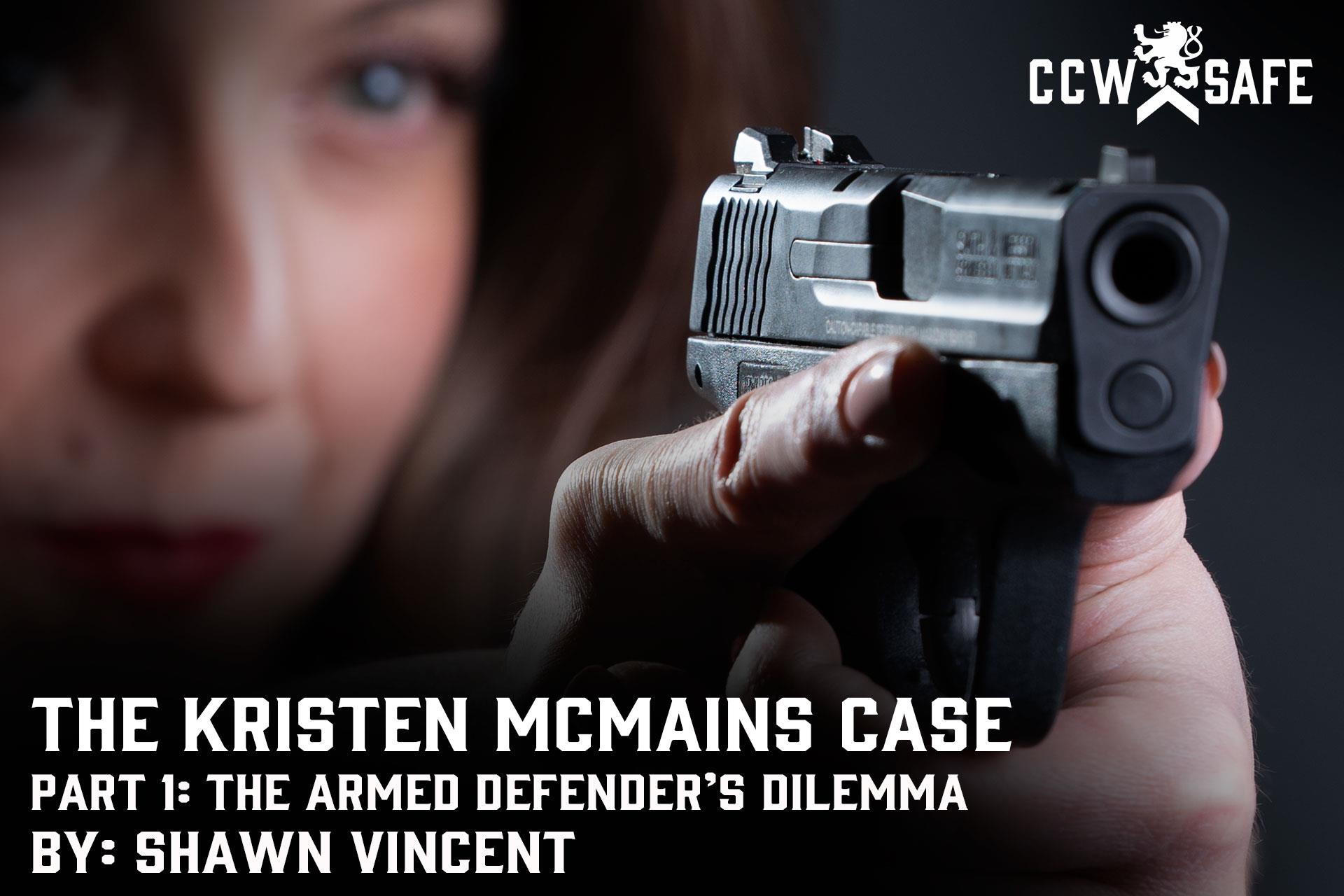
Posted on June 4, 2021
The Kristen McMains Case Pt.1
The Kristen McMains Case
Part 1: The Armed Defender’s Dilemma
The Kristen McMains case is the story of a young woman who used her concealed firearm to end a vicious, life-threatening attack. On the evening of January 26, 2016, the 25-year-old attorney left her office and stepped into a parking garage elevator. A suspicious man had followed her across the skywalk and joined her. As the elevator doors closed, McMains’ fear spiked when the stranger didn’t push a button. “I had the instinctive feeling I was going to die tonight,” she said, “unless I did something.”
When the doors opened on her level of the parking garage, McMains made a run for it. The stranger followed and caught up to her when she reached her car. According to the Courier Journal, “she was only able to get one leg inside before he tackled her, slammed her head, and stabbed at her abdomen with a rusty, serrated knife.”
McMains fought back. She fought back so hard, in fact, that in the resulting melee, she ripped off all 10 fingernails. Ultimately, she managed to reach into her purse to retrieve the .32 Beretta Tomcat her father had purchased for her. The attacker took bullets in the neck and the buttocks before retreating. Police identified 27-year-old John Ganobcik as the attacker, and he ultimately pled guilty to robbery and attempted kidnapping, and he’s currently serving a 15-year prison sentence.
McMains, of course, was never charged in the shooting. Don West, criminal defense attorney and National Trial Counsel for CCW Safe, says that “Even if the attacker didn’t have a knife, Ms. McMains is reasonably in fear of great bodily harm or death. His intent is clear, and his ability to inflict that harm is clear, even without a weapon.” It is clear-cut self-defense.
One could argue that when Ganobcik entered the elevator, McMains’s fear was reasonable, but the attacker had not yet demonstrated his intent, and the threat was not imminent. Don says, “You can’t shoot somebody in an elevator because they give you a funny look or even say something — unless you can articulate a clear basis on why you feared great bodily harm or death.” Once McMains bolted to her vehicle and Ganobcik ran in pursuit, the attacker had made his intentions more clear, but at this point, the attacker wasn’t clearly armed, and had McMains opened fire, it may have been too soon from a legal perspective, and she may have exposed herself to significant legal risk.
“Once he laid hands on her,” Don West says, “and certainly as he began to try to physically overwhelm her, all of those fears that may have been potentially irrational or not truly reasonable were now clearly manifested, and she had every right and every reason to defend herself with lethal force.”
McMains did everything right to minimize her legal risk, but from a tactical standpoint, it can be argued that she waited too long to meet her attacker with force. Concealed carriers shouldn’t have to wait until someone attempts to stab them with a rusty, serrated blade before defending themselves. Managing the delicate balance between firing before an attacker causes serious harm but not before being legally justified is a conundrum we call the armed defender’s dilemma.
One solution to the armed defender’s dilemma is recognizing that the firearm is not the only tool in a defender’s toolbox and that there are opportunities to mitigate encounters with suspicious people before deadly force becomes necessary. Not long ago, I spoke to firearms instructor Tatiana Whitlock and CCW Safe’s own Steve Moses about the Kristen McMains case. While McMains is to be commended for successfully fighting off her attacker and saving her own life, both Tatiana and Steve offered some suggestions on how someone in her situation could have handled the threat differently. These are by no means criticisms of McMains’s actions, rather they are opportunities for concealed carriers to learn from her harrowing experience.
Tatiana Whitlock says, “We love to rationalize ourselves out of fear.” She refers to the “normalcy bias” that describes people’s tendencies to dismiss warning signs. “McMains had a gut feeling that did not feel right. She knew something was wrong,” Tatiana says. “If you have an opportunity to leave, we strongly recommend you leave.”
McMannis became suspicious of Ganobcik when she felt he was following her on the skywalk. Had she given more credence to her feelings, she might have chosen to turn around and head back to the relative safety of her office building rather than draw her potential attacker into the isolation of an elevator and subsequently the parking garage. Tatiana says, “If someone walks into an elevator, you also have an opportunity to get out. Even if that’s not your floor; they don’t know that. So don’t be stuck in a compartment with somebody that you’re uncomfortable with. Get out and leave.”
Steve Moses talks about managing contacts as a concealed carrier, and part of dealing with suspicious people is “acknowledging a person’s presence and letting them know that you have seen them.” It’s a way of demonstrating that you’re aware of them, that you’re being vigilant, and that you’re not an easy target who is distracted and unsuspecting. Steve also recommends verbally engaging a threatening person, perhaps saying, “Hey, I need you to stay back.” Had McMains done this before getting on the elevator, Ganobcik may have abandoned the attack, or it may have caused him to initiate the confrontation in a space where McMains had better options for escaping, easier access to her firearm, and where there would have been a greater likelihood of a witness intervening.
But McMains did get on the elevator, and she was unable or unwilling to exit once Ganobcik stepped in. When the elevator doors opened in the parking garage, Steve says that McMains was smart to bolt, but running to her car wasn’t necessarily the best choice. Steve says, “If I’m going to run a short distance and then stop and try to get into my car, which I assume is going to be locked, I’m going to have to open the door, and that’s going to slow me down and give somebody an opportunity to close on me.” A better alternative would have been to keep running to where there were other people, or if that wasn’t an option, to put a barrier between herself and the attacker — such as a parked car. It would have given her the option to deploy a less lethal force option or make a defensive display — both of which would likely have been legally justified because the attacker had pursued her. By fleeing to her car, McMains had put herself in a confined space where it was more difficult to deploy her firearm, and she had unwittingly given her attacker the means to drive away and kidnap her.
The lesson for concealed carriers is that you should trust your intuition when you encounter people who make you uncomfortable, and you should adapt your behavior accordingly. Don’t be afraid to let suspicious people know that they are “on your radar” by making confident eye contact. If someone suspicious approaches you, feel free to give them a verbal warning to stay back; it’s a great way to make them reveal their intentions at a distance where you still have options. If someone is following you, it’s better to lead them to a safer place; don’t lead them to a dark, isolated place, even if that’s where you were headed. Concealed carriers who remain vigilant, who assess threats and make efforts to acknowledge and evade suspicious contacts are less likely to be drawn into deadly encounters, and they’re more likely to be found justified if forced to resort to deadly force.
